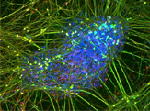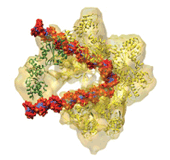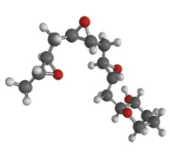How do cells talk to each other?
What controls gene activity?
How do proteins shape themselves so they can work properly?
Why should we care?
That last question is one of the most important of all.
Understanding how life works may not have an immediate impact on our health. But over time, this sort of study—called basic research—paves the way for a wealth of medical advances. By uncovering the cellular or molecular changes involved in diseases, basic research points to approaches for prevention or treatment. Basic and other types of research also provide jobs, stimulate the launch of new companies and help the U.S. maintain its global competitiveness.
Much of the nation’s basic biomedical and behavioral research is made possible by funding from the National Institute of General Medical Sciences (NIGMS), a part of the National Institutes of Health.
Basic Research Pays Off
The goal of basic research is broad—to learn the biological rules of life.The applications of basic research are similarly wide-ranging, including:
- New and improved medicines,
- Diagnostic tests,
- Body-imaging technology, and
- Better organ donor matching.
 Sometimes, basic research has unexpected applications. For example, studies on how viruses infect bacteria led to the discovery of restriction enzymes, a cornerstone of the biotechnology industry. Research on how electric fields affect bacteria led to an important cancer medicine, Cisplatin. Another cancer drug, Velcade®, grew out of studies on a cellular garbage disposal system.
Sometimes, basic research has unexpected applications. For example, studies on how viruses infect bacteria led to the discovery of restriction enzymes, a cornerstone of the biotechnology industry. Research on how electric fields affect bacteria led to an important cancer medicine, Cisplatin. Another cancer drug, Velcade®, grew out of studies on a cellular garbage disposal system.
Some basic research spinoffs are nonmedical, such as:
- Freeze-drying, which was created to concentrate and preserve laboratory samples;
- Laundry stain removers, meat tenderizers and other products that came from studies of digestive enzymes; and
- Improved paternity testing and criminal forensics using a technique developed to mass-produce specific pieces of DNA for study.
Basic research provides an impressive return on investment. Regardless of what measure is used—reduced health care costs or increased productivity from longer, healthier lives—every dollar spent on basic research yields returns ranging from $10 to more than $80.
"The pursuit of curiosity about the basic facts of nature has proven … to be the route by which the successful drugs and devices of modern medicine were [most often] discovered."
—Nobel Laureate Arthur Kornberg
What Makes Good Research?
Start with creative investigators. Give them laboratory equipment and other resources, plus time and the freedom to pursue their curiosity. Await the advance of knowledge—usually as insights that add pieces to solving a scientific puzzle, occasionally as breakthrough discoveries.
These days, biomedical research is often a team activity. Groups of investigators, including scientists in training, work together to answer important scientific questions. Researchers with different skills and expertise may collaborate to tackle especially complex challenges.
Simple organisms also play key roles in research. At the molecular level, organisms like bacteria, fruit flies and mice are very similar to people. The cells of all living creatures make fuel, build proteins, transport materials and dispose of wastes. And we all use similar genetic and biochemical strategies to accomplish these tasks. Understanding these similarities allows researchers to learn about human biology by studying the life processes of well-characterized “model organisms.”
Great Benefits to Humankind
A strong testament to the far-reaching impact of basic research comes from the Nobel Prizes. These prestigious honors recognize people working in specific fields who, as specified in Alfred Nobel’s will, “have conferred the greatest benefit on mankind.”
NIGMS has a long history of supporting Nobelists. In almost every year since the Institute was created, at least one of the laureates in physiology or medicine or in chemistry received research funding from NIGMS. A list of NIGMS-supported Nobelists is at http://www.nigms.nih.gov/GMNobelists.htm.
Spotlights on Basic Research

Among the advances that scientists have made with NIGMS support are:
- Discovering a gene-silencing process called RNA interference, or RNAi, that is both a powerful research tool and a promising new approach for treating diseases.
- Revealing how a protein’s shape affects its function, which plays a key role in health and disease and also informs the design of new drugs.
- Explaining how genes affect the way a person responds to drugs, including those to treat cancer and prevent blood clots.
- Shedding light on the critical functions of carbohydrates, sugar molecules found on all living cells that are vital to fertilization, blood clotting, inflammation and viral infection.
- Developing new methods to look inside cells and other living systems, advancing what we know about basic life processes in a range of organisms.
Looking Ahead

Some promising avenues of basic research include:
- Learning how cells move might reveal ways to stop the spread of cancer.
- Studying the way cells die could open new approaches to treating diseases linked to excess cell death, like Alzheimer’s and Parkinson’s.
- Understanding the molecular differences between bacterial and human cells could point to new targets for antibiotic drugs.
- Devising easy ways to synthesize natural products in the laboratory could yield better and less expensive medicines.
- Exploring how the body responds to traumatic injuries could advance patient care in the emergency department.
NIGMS is a part of the National Institutes of Health that supports basic research to increase our understanding of life processes and lay the foundation for advances in disease diagnosis, treatment and prevention. For more information on the Institute's research and training programs, see http://www.nigms.nih.gov.
Content reviewed November 2012